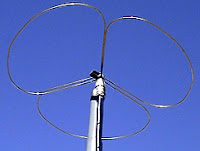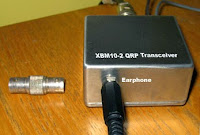Author Archive
 Big wheel antenna
Big wheel antenna
 |
| Big Wheel for 2m |
A good 2m antenna for horizontal polarisation is the big wheel. Quite a few beacons use these as they require no rotator and a couple of these stacked give about 5dBd gain horizontally. So, these would be ideal for fixed station use. They would suit me well for UKAC 2m contests and general 2m SSB/CW use. I know that my 3 el, hand rotated, beam has about the same gain. One big wheel alone is better than a halo, but two suitably phased would be better than a small beam.
 10m BitX transceiver
10m BitX transceiver
I notice that someone has created a 10m (28MHz) version of the BitX transceiver. Yes, all would like more details but we don’t know who you are!
Anonymous said: “I have successfully designed and built a 28MHz version of the BITX transceiver. The main reason for this project was to drive homebrew transverters for 6, 4 and 2Metres. Contact me if you would like details.”
 Fourbox transceiver
Fourbox transceiver
 |
| G7CKF’s Fourbox |
Jenny, G7CKF has now taken the 2m Fredbox design and created a 4m version called the “Fourbox”.
Hi Roger,
I feel I should drop you a line with my thanks and the link below, I’ve used your QRP AM transceivers as the basis for a 4M transceiver and published it on my blog. I’ve come back to amateur radio after a 20 year absence and since construction was always my main interest in the hobby I reached for the soldering iron.
http://thekeywordgeek.blogspot.co.uk/2015/05/a- transceiver-for-not-lot.html
There is no sparkling new insight to be had from it as it’s pretty much your fredbox with slightly bigger coils. There is no crystal because I am cheating and using a Raspberry Pi clock generator to make my 70.260MHz.
My QTH is IO91lw, between Bicester and Buckingham and rather low lying. Very little 4M activity hereabouts, sadly, so the chances of my actually working anyone with it are slim. But that’s not really the point of building, is it.
Anyway, hope you find it of interest, and thanks again for sharing your designs.Jenny, G7CKF
 Optical communications over the horizon
Optical communications over the horizon
I have been too unwell to do this recently, but not long before my brain bleed (Sept 2013) I was amazed at optical communications over the horizon, non line of sight (NLOS) using clear air scattering.
The inspiration for all my optical experiments came from Stuart Wisher G8CYW who did a great series in RadCom a few years ago.
 | |
| Testing optics |
My home made transmitter only consumed about 0.7W from a red LED bought on the internet. My homemade RX and TX used homemade optics based around cheap drain pipes and cheap magnifying glasses. The whole RX and TX were simple and low cost. Only simple test gear was needed too. It is a bit like microwaves, but easier to build and test.
There was no sign at all of the TX beam in the sky. All alignment used dead reckoning with some panning at the RX end to find the TX.
Using free PC software and QRSS3 helped as bandwidths as low as 0.37Hz were possible.
When fitter I want to try infra-red LEDs instead.
See https://sites.google.com/site/g3xbmqrp3/optical/481thz-nlos.
 How simple?
How simple?
Some years ago I attempted to see how few components were needed to communicate on 10m. The Lesser Chirpy was the best I could manage. This was a derivative of The Chirpy, which worked, but had far too much chirp!
Looking at the circuit I see I could save 1 component by replacing C1 and C2 by preset C’s and shorting out C3. This would allow the TX-RX offset to be set. If one was made a variable rather than a preset the RX-TX offset could be adjustable.
Since being ill I have not tried the rig. A limitation was the limited RX sensitivity, meaning only stronger stations would be workable. However, the rig does work and is very simple. Another possibility is to switch to an external RX but allow the internal RX to be used when signals are strong enough. The TX power is certainly enough to span the Atlantic and work all over Europe.
The secret to low chirp on 10m is the use of FSK rather than CW. Essentially the TX changes frequency rather than go from RX to TX every time. This means full break-in is not possible in such a simple circuit. Can you do better? If so, I’d love to see the schematic please. I make no great claims for my circuit, which is an amalgam of ideas. Pure fun!
 Pixie kit prices – truly incredible prices
Pixie kit prices – truly incredible prices
Since my post earlier on this blog about low cost 40m Pixie kits from the Far East, I have been told that Bangood was selling these kits today for a staggeringly low price! This information is thanks to Spence M0STO. Earlier they were for sale at an incredible £2.67.
At this price you might just buy the crystal here in the UK! The kit comes with ALL parts (apart from battery, key and headphones) and a very nice silk-screened PCB. Don’t forget this is with FREE shipping. Unbelievable.
My kit from them worked first time. It was the first time I’d built anything in a LONG time because of my stroke. At this price it is an offer too good to turn down. AM breakthrough was perfectly usable (i.e. low) and RX sensitivity fine. I got over 400mW out too. Don’t forget, this is a complete 40m CW transceiver.
Sorry for the double post but the kits are here and the Customer Service is second to none. Beware the prices change daily inline with currency. http://www.banggood.com/DIY-
Radio-40M-CW-Shortwave- Transmitter-Kit-Receiver-7_ 023-7_026MHz-p-973111.html
 DST 100 receiver
DST 100 receiver
 My very first communications receiver weighed a ton (it took 2 people to move it!) and was a DST100. I believe it was made by Murphy during WW2. This receiver, I have since learnt, was designed for intercept listening. It was built like a tank with a huge rotary turret tuning unit. The radio cost £7 from a local garage and it was overhauled (new valves?) by (the now late) G3CHN. It covered from around 50kHz to over 30MHz and heard some impressive DX. I was always puzzled why signals were so broad on the lowest range, not realising at the time that it covered 50 to about 150 kilohertz! This was in 1962.
My very first communications receiver weighed a ton (it took 2 people to move it!) and was a DST100. I believe it was made by Murphy during WW2. This receiver, I have since learnt, was designed for intercept listening. It was built like a tank with a huge rotary turret tuning unit. The radio cost £7 from a local garage and it was overhauled (new valves?) by (the now late) G3CHN. It covered from around 50kHz to over 30MHz and heard some impressive DX. I was always puzzled why signals were so broad on the lowest range, not realising at the time that it covered 50 to about 150 kilohertz! This was in 1962.
At that time there was little amateur band gear available (none from Japan) and lots of us used WW2 surplus gear which was available at low cost from many suppliers. Popular receivers were the AR88 and CR100. Transmitter-receivers included the WS19, WS38 and 52 sets.
Amateur radio in the 1950s and 1960s was quite different with lots of HF AM still and most people building their own transmitters. SSB was in its infancy. In many ways it was the high point of the hobby, although today we are blessed with low cost gear, free software, more modes and more bands. The hobby means different things to different people. Long may it continue.














